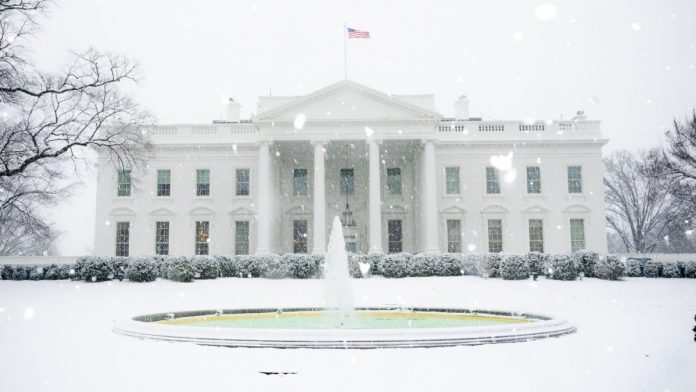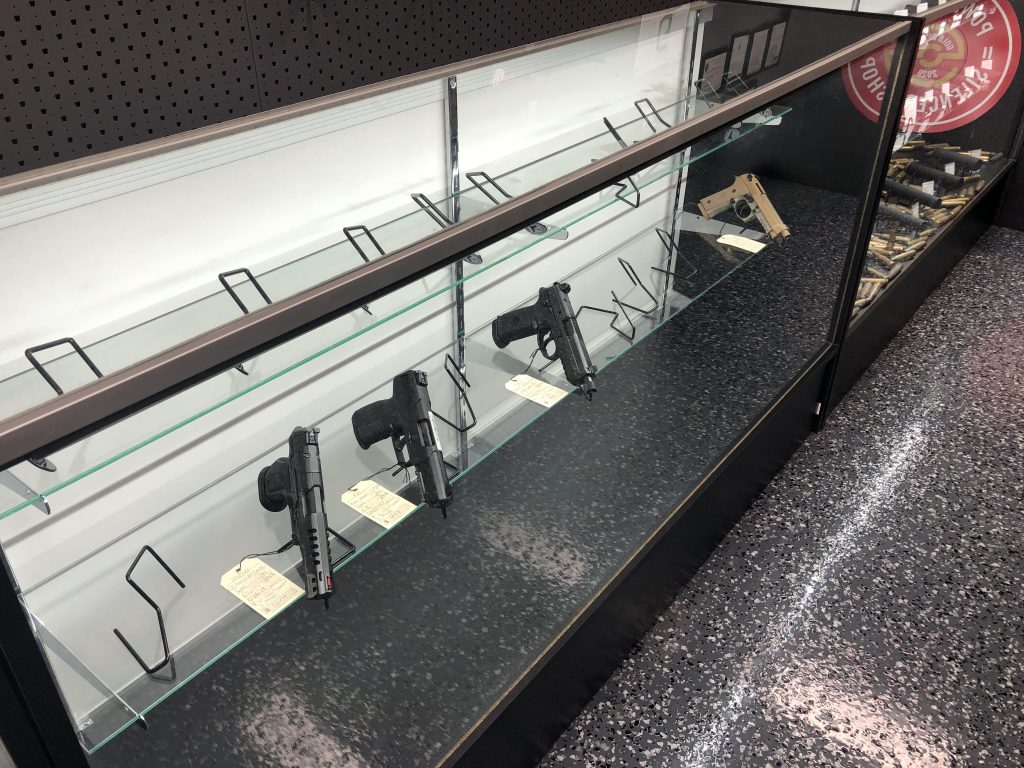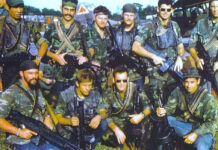
Welcome back, let’s get cracking.
The National Firearms Commerce and Trafficking Assessment, NFCTA: Crime Guns – Volume Two covers the 2017-2021 time period and collects data on states and cities interactions with firearms and attempts to categorize to track trends and provide information. There is a lot to unpack in this report and it is very informative.
NPR had this to say, however…
6 major takeaways from the ATF’s first report in 20 years on U.S. gun crime
Let’s start right back up with point number 4 that NPR says is a “Major Takeaway”.
4. In five years, the number of illegal machine gun conversion devices recovered by law enforcement agencies has jumped 570%
Conversion devices make semi-automatic firearms into fully automatic machines guns.
And note that they are legal if the proper NFA paperwork is completed by a manufacturer. They are not legal in general circulation. They are not complex devices either. There is a reason that the ‘coat hanger’ and 3D printed auto-sears for AR-15’s keep popping up problematically, they are a very simple series of parts.
To put this new data into context, from 2012 to 2016, ATF reported the recovery of 814 machine gun conversion devices, the agency told NPR. From 2017 to 2021, however, that number skyrocketed to 5,454 recoveries.
Even though these devices, also called switches, have been illegal for decades “they are just more readily available and accessible than they’ve ever been,” Densley said.
Thank you Wish.com.
Most of these were ‘switches’ that replace the backplate of a Glock, and for a while they were easily orderable. You saw ads for them on Facebook, IG, and other social media advertising them as an ‘airsoft’ accessory. Then there’s the whole simple possession vs constructive possession of the parts and a gun that can take them, similar to simple possession or constructive possession of the parts to assemble an SBR, but different due to the closed nature of the machine gun registry portion of the NFA Registrar. It’s a quagmirical mess of legalese that argues about what the definition of ‘is’ is instead of putting violent criminals in prison.
3D Printing, fast multi-source data access, and the fact that firearms are not overly complicated machines make illegal and inaccessible two very different things. The machine gun is an old invention, dating from the late 1800’s and early 1900’s. We’ve gotten a little better at making them and the materials they are made out of, but they haven’t dramatically changed in function in over a century.
So while the internet and some modern technologies have made them ‘more readily available’ they’ve never really been unavailable, making them is not overly complicated. It’s not a simple as assembling a TV stand you ordered from Amazon, but it’s not significantly more complex than measuring out and building your own TV stand from from scratch lumber from the hardware store. To make one well, it takes some middle level mechanical and material understanding and access to some not inexpensive but not prohibitively expensive machinery.
The relatively few automatics in circulation is a combination of the risk and the practicality. Having an automatic isn’t actually that much more useful to a criminal and the penalty for being caught with one, not the inability to possess one, are much steeper than a semi-auto. The ‘WishSwitches’ changed that equation by upping the ease of access which is why we saw the number spike. That Chinese device, and China doesn’t care about our laws one bit, changed the ease of access dramatically while all the other risks remained static.
Making a Glock blaze ammo in a direction is only marginally more dangerous, and in some instances less dangerous, than having it throw rounds vaguely in that direction in semi-auto. A drive-by type shooting that sprays 50 rounds of 9mm at full auto from one guy with one Glock and a drum magazine, or 51 rounds of semi-auto from three with normal Glocks and normal magazines or one guy with a the same drum as the first example, or one guy with 5 rounds of 00 buckshot in a cheap pump shotgun all constitute roughly the same risk environment to those being shot at. The risk to the shooter(s) varies fairly dramatically, from a legal standpoint. The shooting is obviously illegal, automatic is super extra illegal but made the shooting logistically easier to do, the three gun approach is illegal for more involved but regular Glocks are much easier to get and will come with the requisite normal capacity magazine, the shotgun involves the least amount logistically and is the easiest to acquire but it is larger and far less concealable for circumstances before and after the planned attack.
Throughout all of that, the initial illegality of the shooting doesn’t change and the people who commit these crimes accept that. Having an automatic in the commission of that or a similar violent attack won’t really materially alter the risk of a long or life sentence that the attempted homicide or homicide will net them.
Mandalay Bay and North Hollywood both are illustrative real world examples of ‘high fire rate does not equal a comparative high body count’, even with the circumstances decidedly favoring the shooter at Mandalay Bay. That was a terrifyingly well put together attack that was mitigated by the amateur level of fire discipline and the fact he never detonated the explosives. It throws its example in the face of those who say ‘well, the shooter was carrying enough ammo to commit a bigger atrocity!’. Yes, and we have a real world example of someone attempting that very atrocity against a densely populated target and firing that dramatically larger number of rounds and still running into a damage inflicted cap as the actions of those attacked and those responding to the attack got them out of immediate danger and put pressure on the shooter, who then eventually killed himself.
Point,
In the dozen other deadliest mass shootings in the US, the number of dead compared to the number of injured usually ratios closely.

The highest injured ratio is a little over 1:2 in Fort Hood and the lowest is 13.5:1 in Newtown. Newtown was a close deadly enclosed environment against mostly children and the shooter was contained there. We have only one other shooting to compare Mandalay to with greater than 100 casualties in the US. We have a few in Europe, the Bataclan being most the comparable. But the circumstances surrounding each of these attacks and how the casualty counts were ultimately generated vary widely.
The near automatic fire rate, range, and space for people to spread out once they recognized the noise of the bump stock equipped rifles in Las Vegas resulted in the dead to injured ratio of nearly 1:7 killed to injured by gunfire, we are excluding circumstantial injuries since we are discussing the lethality of high fire rates specifically. Had the shooter employed more discipline in their attack, given what we see from Pulse and Virginia Tech as the two next deadliest attacks, he could have produced a body count in the hundreds given the entrapped and densely populated environment. The body and injury count could have skyrocketed further had the IEDs been placed, made properly for maximum casualty infliction, and detonated when surrounded by the fleeing. There are dozens of plausible scenarios that make Mandalay Bay far more horrific, and they all deal with competence.
No law would prevent it. No law would change the raw casualty causing potential possessed by the attacker even if we partially illegalize firearm type or possession. Other firearms would have equal and potentially greater injurious impact.
Automatic fire does not necessarily produce more deaths, it is a variation on an already highly dangerous method of injury that is already capable of producing staggering casualties. It can produce a high casualty count but it does not outstrip what a similar semi-automatic firearm, or explosives, or vehicle could produce and has produced in a similar densely populated environment.
TL;DR: Automatic fire is not a special risk in the already extreme risk circumstance of a shooting. Multiple other methods of injury exist that could reasonably cause the same level of injury and damage and those are left far less regulated in meaningfully inhibitive ways than an automatic firearm is. It’s about the equivalent of asking whether the 9.1 or 9.3 earthquake that destroyed the town was more dangerous, they were both well beyond the catastrophe threshold.
We are trying to stop the most deranged and dedicated to destructive action members of humanity and deter them with a ‘no parking between 8am and noon’ sign.
Last year, The Trace and VICE News documented the rise of these automatic conversion devices. These small switches “easily modify semiautomatic weapons to fire more than 1,200 rounds per minute, and sidestep the federal government’s strict licensing requirements for automatic weapons.”
Accessing these illegal devices has become easier in recent years, thanks to the rise of social media and the internet, Densley said. There are videos online teaching people how to make them at home with a 3D printer, he said. They’re also coming from overseas, mainly China.
You can slap a penalty on it, you cannot prevent access to it. That penalty can be steep, it is even. It is 10 years in prison and $250,000.00. But we do not very evenly apply that penalty, often let violators plea out, and in general acknowledge without actually changing the laws to reflect the reality that it is a hostile act with a weapon that is the problem, not the weapon itself.
The huge jump in law enforcement agencies recovering these devices is thanks to the ATF’s effort over the past two years to educate local agencies on the identification and reporting of conversion devices, the agency said.
Or their sudden influx thanks to Wish.com and China, but pat yourselves on the back ATF. The public has access to all this information but I’m sure law enforcement could only figure it out through the ATF’s efforts. [/sarc]
Crime labs are the ones confirming these devices and the working or otherwise condition of the firearms.
Guns fitted with these devices and used in shootings are hard to control and often result in serious collateral damage, Densley said.
That continues to fly in the face of the assertions that more lethal, we are now saying they are more damaging to the general environment. Which is it? It’s almost like the employment of a machine gun is a complicated combat skill and its mere presence doesn’t make a situation eminently more dangerous than ‘deranged lunatic with a gun’ already does.
“This is where you get those shootings where it’s like we found 100 shell casings on the floor. And you know, 20 people got shot at the bar,” he said.
For example, a mass shooting on April 3, 2022 in Sacramento in which six people died was committed with a gun fitted with such a device, The Trace reported.
Would this shooting have materially changed much by changing the firearm? That is the question we need to ask when we are discussing these things. Yes, these were the circumstances for this particular shooting, but would those circumstances be easily repeatable with different variables. The answer to that question is invariably, ‘Yes these circumstances would be easily repeatable with a number of other non-automatic firearms and non–firearm methods of injury’ and we keep glossing over that fact in a rush to prove how dangerous this specific shooting was that an extra illegal gun, used often by people who aren’t allowed to legally have guns anyway, was very dangerous and we need to make it more illegalerer-er than it is already more illegal to stop these people from dangerously illegaling.
5. Pistols represented nearly 70% of the crime guns traced between 2017 and 2021
Semi-automatic rifles like the AR-15 often make headlines when they are used to commit mass shootings in the United States. But handguns are most often used to commit crimes, according to ATF data.
We really buried the overall salient point on this one, didn’t we. 5th point in the list is the most common firearm used in crime. I mentioned this earlier and the information and ratios surrounding it in Part 1: https://gatdaily.com/articles/the-atfs-5-year-report-on-guns-tells-us-some-things-npr-swung-and-missed-a-few-part-1/.

The percentage of these handguns recovered in crimes and submitted for tracing by law enforcement agencies increased from 62% in 2017 to 75% in 2020. And of the more than 1.3 million pistols used in crimes traced between 2017 and 2021, 19.6% were manufactured by Glock.
Let’s also admit that this is a bit of misdirection in its own right. The ATF count revolvers, an additional 11% of crime guns with 211,590 traces, as a separate category despite the fact that revolvers are handguns. Small, concealable, and multishot, the revolver is very serviceable.
Meaning a total of 79% of crime firearms are handguns.
“But Keith!” You cry out, “There are super dangerous rifle caliber pistols, AR and AK types! Surely those represent a massive portion of ‘pistols’ in the total, right?”
Nope… 5.56 (6,940) and 7.62 (10,713, no distinction is made between .300BLK, 7.62×39, or 7.62×51) account for a total of 1.3% of traced crime handguns. The anemic .25 ACP is a more popular caliber at 2.4%, 31,591 guns, recovered and traced.
So excluding rifle caliber handguns, 77.7% of crime guns are traditional handguns or traditional revolvers.
Notice NPR stopped using full numbers and dropped to just percentages? Remember that 19.6% is 255,055 guns. We wouldn’t want that number to clash with dramatically smaller numbers, like 5,454 machine guns (which were mostly Glocks or Glock clones too, because that is what a switch fits).
When we can say things like 570% increase and 5,454 guns we make both of those numbers sound terrifying. They seem dramatically less terrifying against numbers like 647,014, which was the number of regular 9mm semi-autos traced from a crime.
“It’s probably also the most likely to be stolen. And it’s also the most likely to wind up on the streets,” Densley said of the Glock pistol.
Glock is the most popular handgun manufacturer in the world. I would bet they also account for a significant portion of the number of guns stolen from government sources. 25,904 guns stolen from the government if you’ll recall, unknown how many were Glocks.
This gun is both well designed and well marketed, he said. They also allow for the popular conversion devices to be put into these guns, making them more lethal and used in crimes more often.
Eh, we just said there were only 5,454 machine guns recovered and not all of those are going to be ‘switched’ guns so how much ‘more often’ was it really?
“There’s a cachet with the Glock versus some other brands as well,” he said. “And so I think all of that contributes to that phenomenon.”
Most. Popular. Handgun. Worldwide.
I don’t think we need to dig into the obvious too deeply here. We are going to see a surge in Sig pistol market share soon too. Why? They got popular after the M17 contract and several other wins.
It is no surprise to anyone with a few neurons that fire correctly that the influx of ‘stimulus’ amounts that happen to match the price of popular handgun models led directly to a lot of those gun sales. The government actually funded this problem as part of their ‘fix’ to the other problem they created by hard stopping the US economic systems and letting inner cities burn here and there.
But let’s not look at that one too hard. Wouldn’t want to imply any government culpability in both over straining, and then arming the strained groups with just enough money for that and not much else, and then acting surprised when some of those strained populations used the currency of violence to solve issues they were experiencing. Especially prevalent among groups already comfortable with violence as one of their currency and communication forms.
Weird, right?
Why are we acting surprised that people armed up during the pandemic and the riots? Legally or otherwise.
6. There’s a lot of data, but it’s still limited
Of course it’s ‘still limited’. But it is indicative of many things and we can draw conclusions, ones that you at NPR don’t necessarily want to draw, as it points out the limits of regulatory efficacy, the actual scale of various risks, and what the real problems are when we combine it with other available data.
The report only reflects a glimpse of the full picture when it comes to guns in the U.S.]
Shocking. Let’s start with between 2017 and 2021 there were 1,482,861 traces for crime guns but 158,358,886 NICS checks. The NICS deny rate for the last two of those years was 1.33% combined, 2020’s rate was slightly higher than 2021’s. If we use that deny rate as a base for the whole five years we end up with 2,106,173 denied transfers, allegedly. Which doesn’t line up with the math, funny enough, as that is more denials than NICS has delivered in its entire history, 2,039,507.
The better extrapolated number that doesn’t get clearly conveyed in the report is 1.33% of the 31% of checks referred to NICS record check and not immediately passed (69% of checks), this is only approximately 652,913 denials in those five years, 338,949 of those confirmed in 2020 and 2021.
Meaning denied background check volume accounts for about half of the comparable criminal trace volume and only a 0.41% actual denial rate. So what exactly are background checks accomplishing? For every denied background check two crime guns were recovered, do we have any data indicative of whether those with a denied check were found as a possessor of one of these crime guns?
[Firearm tracing, as well as ballistic imaging policies and practices, vary across these local agencies, the ATF said.
The results presented in the report are thus limited and is not “representative of all crime guns used by offenders in the U.S. during this study period,” the agency said in its report.
They don’t have to be representative of all if they are representative of a large enough sample. That is how statistical modeling and sampling work, if we collect enough data and enough instances we will be accurately projecting the rest of the data within a very reasonable error margin.
I harp on crime being from a unique motivator and individually accountable perspective but from the larger analysis of motivators we can categorize and see these things from the macro picture level. That is useful information. What we can’t do is think that our macro solution concepts influence the individual motivations directly. Making murder illegal doesn’t remove the motives for murder, it just places a potential consequence into the more complex socioeconomic equation of commiting a murder.
In 2021, 47.2% of law enforcement agencies (8,679 out of 17,981 agencies) were participating in ATF’s eTrace program, which tracks firearms used in crimes. And as of 2021, there were only 259 cities with National Integrated Ballistic Information Network sites (which analyzes ballistic information). These databases are where the ATF pulled information for this report.
Even with this caveat, the ATF and experts say this information is a huge step in better understanding gun violence in the U.S. It comes at a time when data is pointing to a rise in deadly gun violence across the country.
Now, policymakers have another tool to address the problem, Densley said. “This is important information for understanding how gun violence evolves over time.”
Yes, equally important is the actual understanding of the information and not cherry picking stats to make your particular pet point look scarier than it is.
We’re constantly told ‘Assault Weapons’ are a huge problem, then 77.7% of crime guns are handguns.
We need to ban ‘Assault Weapons’ and yet the combined total of ALL pistols and rifles recovered in ‘Assault Weapon’ calibers, which means we have some overlap with non-‘Assault Weapon’ firearms in the same calibers, is 116,332. Meaning Glock handguns in their boringly regular state account for a 219.24% greater risk of being used in a crime than all assault weapons during this five year period. That period includes the chaotic and particularly violent 2020 and 2021. Indications are the ’22 and ’23 are looked and are looking better, amazing what happens when we re-engage socially cohesive services.
The damage to social and societal trust during this period will have a longer and less predictable fallout and healing period.
Conclusions
The NPR Article on the report ends up doing some disservice to the information contained in the National Firearms Commerce and Trafficking Assessment (NFCTA): Crime Guns – Volume Two and the report itself has a couple of places where I would like them to spend some effort for contextual clarity.
I will give them credit for the overall effort, the obfuscation contained is mildly annoying at most. I might just be jaded and expecting it though.
What we end up seeing is that the things that we are told are problems look very different in wide context vs in isolation. In the wider context there are hundreds of millions of guns, gun owners, and only a small percentage are a problem on any given day. A substantial percentage of that small percentage are also habituals problems and any number of variables can come together to make a tragic result.
We must not let up on our efforts to reduce the occurrences of the problems but blowing those problems out of proportion does far more harm than good when it comes to crafting truly effective policy solutions and wider socioeconomic goals because it will breed exaggerated overreactions and cultivate an environment of unkept promises from the policymakers who promise the impossible and fail to deliver.
We cannot rid ourselves of ‘gun crime’ because that is a misnomer. We cannot rid ourselves of most forms of violence because the motivators, subjective, and objective gains from the violent action are hard to mitigate and provide total non-violent sources for. That is especially true of the subjective gains where the violence is tied to a cause or ego driven motive.
The best we can do is strive a little everyday to make our little piece of this place a little better and not worry about the things we cannot change and should have little motivation too, it isn’t worth our finite time. Violence will always be with us, when the firearm is obsolete as the individual weapon of choice we will have whatever is next. We keep that reality in check by making the best of life as we can.
We can’t pass a law against gun violence any more than we can pass a law to enforce happiness, so we do these things the hard ways with no guarantees as the only ways. We need to stop believing the snake oil sales folk who are attracted to the political life.



